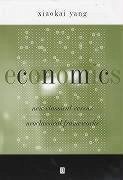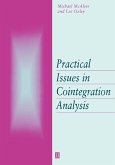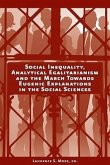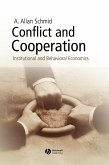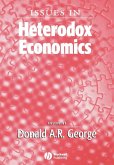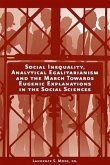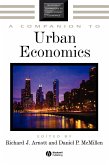- Gebundenes Buch
- Merkliste
- Auf die Merkliste
- Bewerten Bewerten
- Teilen
- Produkt teilen
- Produkterinnerung
- Produkterinnerung
This innovative text ushers in a new way of examining basic economic issues. It teaches economics from a different standpoint, using a division-of-labor theme to eliminate the need for a dichotomy between microeconomics and macroeconomics. This text shows how resource allocation and levels of division of labor are determining factors for demand and supply. It also illustrates the ways that unemployment and business cycles are seen as features of the network of division of labor. While innovative in content, this book keeps the continuity of mainstream economics through a synthesis of existing…mehr
Andere Kunden interessierten sich auch für
![Practical Issues in Cointegration Analysis Practical Issues in Cointegration Analysis]() Practical Issues in Cointegration Analysis65,99 €
Practical Issues in Cointegration Analysis65,99 €![Social Inequality, Analytical Egalitarianism, and the March Towards Eugenic Explanations in the Social Sciences Social Inequality, Analytical Egalitarianism, and the March Towards Eugenic Explanations in the Social Sciences]() Social Inequality, Analytical Egalitarianism, and the March Towards Eugenic Explanations in the Social Sciences56,99 €
Social Inequality, Analytical Egalitarianism, and the March Towards Eugenic Explanations in the Social Sciences56,99 €![Conflict Cooperation Conflict Cooperation]() A Allan SchmidConflict Cooperation149,99 €
A Allan SchmidConflict Cooperation149,99 €![Issues Heterodox Econ Issues Heterodox Econ]() GeorgeIssues Heterodox Econ39,99 €
GeorgeIssues Heterodox Econ39,99 €![The Blackwell Encyclopedic Dictionary of Managerial Economics The Blackwell Encyclopedic Dictionary of Managerial Economics]() The Blackwell Encyclopedic Dictionary of Managerial Economics66,99 €
The Blackwell Encyclopedic Dictionary of Managerial Economics66,99 €![Social Inequality, Analytical Egalitarianism, and the March Towards Eugenic Explanations in the Social Sciences Social Inequality, Analytical Egalitarianism, and the March Towards Eugenic Explanations in the Social Sciences]() Social Inequality, Analytical Egalitarianism, and the March Towards Eugenic Explanations in the Social Sciences120,99 €
Social Inequality, Analytical Egalitarianism, and the March Towards Eugenic Explanations in the Social Sciences120,99 €![A Companion to Urban Economics A Companion to Urban Economics]() Richard Arnott / Daniel McmillenA Companion to Urban Economics266,99 €
Richard Arnott / Daniel McmillenA Companion to Urban Economics266,99 €-
-
-
This innovative text ushers in a new way of examining basic economic issues. It teaches economics from a different standpoint, using a division-of-labor theme to eliminate the need for a dichotomy between microeconomics and macroeconomics. This text shows how resource allocation and levels of division of labor are determining factors for demand and supply. It also illustrates the ways that unemployment and business cycles are seen as features of the network of division of labor. While innovative in content, this book keeps the continuity of mainstream economics through a synthesis of existing and emerging branches of economics. It is an exceptional work that will encourage both creative and critical thinking.
Hinweis: Dieser Artikel kann nur an eine deutsche Lieferadresse ausgeliefert werden.
Hinweis: Dieser Artikel kann nur an eine deutsche Lieferadresse ausgeliefert werden.
Produktdetails
- Produktdetails
- Verlag: Wiley
- Seitenzahl: 784
- Erscheinungstermin: 5. März 2001
- Englisch
- Abmessung: 253mm x 180mm x 46mm
- Gewicht: 1461g
- ISBN-13: 9780631220015
- ISBN-10: 0631220011
- Artikelnr.: 21752794
- Herstellerkennzeichnung
- Libri GmbH
- Europaallee 1
- 36244 Bad Hersfeld
- gpsr@libri.de
- Verlag: Wiley
- Seitenzahl: 784
- Erscheinungstermin: 5. März 2001
- Englisch
- Abmessung: 253mm x 180mm x 46mm
- Gewicht: 1461g
- ISBN-13: 9780631220015
- ISBN-10: 0631220011
- Artikelnr.: 21752794
- Herstellerkennzeichnung
- Libri GmbH
- Europaallee 1
- 36244 Bad Hersfeld
- gpsr@libri.de
Xiaokai Yang is Professor in the Department of Economics at Monash University and an affiliated Fellow in the Center for International Development, Harvard University. His research papers have appeared in The American Economic Review, Journal of Political Economy, and other refereed journals. He is the author of eight books, and is co-author, with Jeffrey Sachs, of Development Economics (Blackwell, 2001).
Part I: Economic Environment: Introduction:.
1. What is Economics?.
Analytical Framework of Economics.
Neoclassical Economics vs. New Classical Economics.
Structure of the Text and Different Ways to Use it.
2. Preference and Utility Function.
Scientific Approach to Studies of Human Behavior.
Preference and Utility Function.
Convex Preference Relation, Quasi-concave Utility Function, Diminishing
Marginal Rates of Substitution, and Desire for Diverse Consumption.
Ordinal vs. Cardinal Theory of Utility and Diminishing Marginal Rate of
Substitution vs. Diminishing Marginal Utility.
3. Production Conditions.
Neoclassical Framework vs. New Classical Framework.
Neoclassical Environment of Production.
New Classical Production Environment.
Endogenous cum Exogenous Comparative Advantage.
Part II: Neoclassical Framework: .
4. Neoclassical Decision Problems.
Budget Constraint and Dichotomy Between Pure Consumers and Firms.
A Pure Consumer's Constrained Utility Maximization Problem.
Comparative Statistics of the Pure Consumer's Utility Maximization Problem.
A Pure Consumer's Expenditure Minimization Problem.
Recovering Utility Function from a Demand System.
Revealed Preference.
A Producer's Decision Problem in a Walrasian Regime.
5. General Equilibrium in the Neoclassical Frameworks.
General Equilibrium in a Walrasian Model.
Neoclassical General Equilibrium Models.
Comparative Statistics of Neoclassical General Equilibrium.
Welfare Implications of the Neoclassical General Equilibrium
Equilibrium in Neoclassical Game models.
Part III: New Classical Framework: .
6. Consumer-producers' Decisions to Choose Optimum Level and Pattern of
Specialization.
The New Classical Framework and Transaction Costs.
Configurations and Corner Solutions in the New Classical Framework.
The Optimum Resource Allocation for a Given Level and Pattern of
Specialization.
The Optimum Level and Pattern of Specialization.
Neoclassical and New Classical Laws of Supply and Elasticity of
Substitution.
7. New Classical General Equilibrium and Its Welfare Implications.
Neoclassical vs. New Classical General Equilibrium.
How Does the Market Coordinate the Division of Labor and Utilize Network
Effects.
Inframarginal Comparative Statistics of New Classical General Equilibrium.
Efficiency of the Invisible Hand.
8. Trade Pattern and Professional Middlemen.
Why Can Professional Middleman Make Money? What Are Determinants for
Business Success.
A Model with Trading Activities and Heterogeneous Parameters.
Decisions to Be a Professional Middleman.
Market Structures and Corner Equilibria.
The Equilibrium Size of the Network of Division of Labor.
Emergence of Professional Middlemen and a Hierarchical Structure of
Economic Organization.
Determinants of Trade Pattern and Successful Business.
Part IV: Institution of the Firm and Pricing through Bargaining and
Contracting: .
9. Labor Market and Institution of the Firm.
What is the Institution of the Firm.
Is It Fair to Have Asymmetric Relationship Between Boss and Employees.
Story behind the Model.
Emergence of the Firm from the Division of Labor.
The Distinction Between ex ante and ex post Production Functions and the
New Classical Analysis of Demand and Supply.
Economies of Division of Labor, Economies of the Firm, and Coase Theorem.
10. Pricing Mechanism Based on Bargaining.
Bargaining Game, Strategic Behavior, Opportunistic Behavior.
Nash Bargaining Game.
Endogenous Transaction Costs caused by Information Asymmetry.
Alternating Offer Bargaining Games.
Dynamic Bargaining Game and the Division of Labor.
How Does Competition for a Greater Share of Gains from the Division of
Labor.
Generate Endogenous Transaction Costs.
How Can Endogenous Transaction Costs be Eliminated by Consideration of
Reputation.
Non-credible Commitment and Soft Budget Constraint.
11. Endogenous Transaction Costs and Theory of Contract, Ownership, and
Residual Rights.
Endogenous Transaction Costs and Moral Hazard.
Neoclassical Principal-agent Models.
A New Classical General Equilibrium Model of Principal-agent.
The Trade off Between Endogenous Transaction Costs caused by Moral Hazard
and Monitoring Cost.
The Grossman-Hart-Moore Model of Optimal Ownership Structure.
Part V: Trade Theory and More General New Classical Models:.
12. Emergence of International Trade from Domestic Trade and Emergence of
New Products.
Endogenous Trade Theory and Endogenous Number of Consumer Goods.
A New Classical Trade Model with Fixed Learning Costs.
How are Demand and Supply Functions Determined by Individuals' Levels of
Specialization.
Inframarginal Comparative Statistics of the Optimum Decisions.
How is the Level of Division of Labor in Society Determined in the Market.
Inframarginal Comparative Statistics of General Equilibrium and Many
Concurrent Economic Phenomena.
Emergence of International Trade from Domestic Trade.
Comovement of Division of Labor and Consumption Variety.
Trade off Between Economies of Specialization and Coordination Costs.
A Neoclassical Model Endogenizing the Number of Consumption Goods on the
Basis of the Trade off Between Economies of Scale and Consumption Variety.
An Extended Murphy-Shleifer-Vishny Model with Compatibility between
Economies of Scale and Competitive Market.
13. Exogenous and Endogenous Comparative Advantages, Division of Labor, and
Trade.
Endogenous vs. Exogenous Comparative Advantage.
A Ricardian Model with Exogenous Comparative Technological Advantage and
Transaction Costs.
Analysis of Decisions vs. Analysis of Equilibrium.
Economic Development and Trade Policy.
Comparative Endowment Advantage and Transaction Efficiency.
14. More General New Classical Models.
Theoretical Foundation of New Classical Economics.
A General New Classical Model with ex ante Different Consumer-producers.
The Existence of General Equilibrium.
Equilibrium Organism and Efficiency of the Invisible Hand in Coordinating
Division of Labor.
A Smithian Model with Dual Structure.
Trade Pattern and Income Distribution.
Part VI: Urbanization, Population, the Trade off Between Working and
Leisure:.
15. Urbanization, Dual Structure Between Urban and Rural Areas, and the
Division of Labor.
Why and How Cities Emerge from the Division of Labor?.
Emergence of Cities and of the Dual Structure Between Urban and Rural
Areas.
Why Can Geographical Concentration of Transactions Improve Transaction
Efficiency.
Simultaneous Endogenization of Level of Division of Labor, Location Pattern
of Residences, Geographical Pattern of Transactions, and Land Prices.
Fujita-Krugman Model of Urbanization.
16. The Trade off Between Work and Leisure and Impacts of the Resource
Endowment and Population on the Division of Labor.
Why Can Division of Labor Enlarge the Scope for the Efficient Trade off
Between Work and Leisure.
Why Leisure Time and Per capita Consumption of Each Goods Increase as
Division of Labor Develops.
Why Can Crisis of Resource Shortage Promote Evolution in Division of Labor
and Productivity.
Implications of High Population Density for Evolution in Division of Labor
through Its Effect on Per capita Investment Cost of Infrastructure.
Part VII: Trade off Between Economies of Division of Labor and Coordination
Reliability of the Network of Division of Labor:.
17. Economics of Property Rights and the Division of Labor.
Uncertainties in Transactions and Economics of Property Rights.
Trade offs among Economies of Division of Labor, Coordination Reliability,
and Benefit of Competition.
Endogenization of Coordination Reliability in Each Transaction.
Substitution between Precision in Specifying and Enforcing Property Rights
and Competition.
18. Insurance and Risk of Coordination Failure of the Network of Division
of Labor.
Uncertainty and Risk Aversion.
A Model with Insurance and Endogenous Specialization in the Absence of
Moral Hazard.
The Division of Labor and Endogenous Transaction Costs caused by Complete
Insurance.
Part VIII: Hierarchical Structure of Division of Labor:.
19. The Division of Labor in Roundabout Production and Emergence of New
Machines and Related New Technology.
New Classical View vs. Neoclassical View on the Emergence of New Producer
Goods and Related New Technology.
A Model with Endogenous Technical Progress, Endogenous Number of Producer
Goods, and Endogenous Specialization.
The Efficient Number of Producer Goods and Level of Specialization.
The Corner Equilibria in 9 Structures.
Concurrent Changes in the Level of Division of Labor, Productivity, and
Input Diversity.
Ex post Production Function, Emergence of New Machines, and Endogenous
Technical Progress.
Changes in Economic Structure and Topological Properties of Economic
Organism.
Evolution in the Number of Producer Goods and Economic Development.
20. Industrialization and the Division of Labor in Roundabout Production.
The Features of Industrialization.
A General Equilibrium Model Endogenizing Production Roundaboutness.
Corner Equilibria and Emergence of New Industry.
Corner Equilibria and Emergence of New Industry.
General Equilibrium and Industrialization.
Changes in the Income Shares of the Industrial and Agricultural Sectors.
The Number of Possible Structures of Transactions Increases More Than
Proportionally as Division of Labor Evolves in Roundabout Production.
21. Hierarchical Structure of the Network of Division of Labor and Related
Transactions.
The Theory of Hierarchy.
One Way Centralized Hierarchy.
A Decentralized Hierarchy of Transactions and the Division of Labor.
Configurations and Market Structures.
The General Equilibrium and Its Inframarginal Comparative Statistics.
Network Hierarchy of Cities and Division of Labor.
Part IX: Economic Development and Economic Growth:.
22. Neoclassical Models of Economic Growth.
Neoclassical vs. New Classical Growth Model and Exogenous vs. Endogenous
Growth Model.
The Ramsey Model and the AK Model.
R&D Based Endogenous Growth Models.
23. Economic Growth Generated by Endogenous Evolution in Division of Labor.
Economies of Specialized Learning by Doing and Endogenous Evolution in
Division of Labor.
A New Classical Dynamic Model with Learning by Doing.
Optimum Speed of Learning by Doing and Evolution of Endogenous Comparative
Advantage.
Endogenous Evolution of the Extent of the Market, Trade Dependence,
Endogenous Comparative Advantages, and Economic Structure.
Empirical Evidences and Rethinking Development Economics and Endogenous
Growth Theory.
Appendix.
The Relationship between the Control Theory and Calculus of Variations.
24. Concurrent Endogenous Evolution in Division of Labor, in the Number of
Goods, and in the Institution of the Firm.
How Can We Simultaneously Endogenize Evolution in Division of Labor and in
the Number of Producer Goods.
A Dynamic Equilibrium Model with Learning by Doing and an Endogenous Number
of Producer Goods.
Dynamic Equilibrium Level of Specialization and Input Variety.
Concurrent Evolution of Specialization, Variety of Producer Goods, and the
Institution of the Firm.
Appendix. 24.1. Proof of Lemma 24.1.
Appendix 24.2. Proof of Proposition 24.1.
Appendix 24.3. Proof of Proposition 24.2.
25. Experiments with Structures of Division of Labor and Evolution in
Organization Information Acquired by Society.
How Does Organization Knowledge Acquired by Society Determine the Level of
Division of Labor.
A Static Model with Endogenous Length of Roundabout Production Chain and
Endogenous Division of Labor.
Interactions Between Dynamic Decisions and Evolution in Organization
Information.
Walrasian Sequential Equilibrium and Concurrent Evolution in Organization
Information and Division of Labor.
Part X: Macroeconomic Phenomena and Endogenous Size of Network of Division
of Labor: .
26. Theory of Capital and Saving.
Neoclassical Theory of Capital.
New Classical Theory of Capital and Savings.
Capital and Division of Labor in Roundabout Production.
27. Money and Division of Labor.
Neoclassical vs. New Classical Theories of Money.
A New Classical Model of Endogenous Monetary Regime.
Possible Structures and Monetary Regimes.
28. New Classical Theory of Business Cycles and Unemployment.
Rethinking Macroeconomics.
Long-run Regular Efficient Business Cycles, Cyclical Unemployment, Long-run
Economic Growth, and Division of Labor in Producing Durable Goods.
A New Classical Dynamic Equilibrium Model of Business Cycles and
Unemployment.
Cyclical vs. non-cyclical Corner Equilibria.
General Price Level, Business Cycles, and Unemployment Rate.
Emergence of Firms and Fiat Money from the Division of Labor.
References.
Index.
1. What is Economics?.
Analytical Framework of Economics.
Neoclassical Economics vs. New Classical Economics.
Structure of the Text and Different Ways to Use it.
2. Preference and Utility Function.
Scientific Approach to Studies of Human Behavior.
Preference and Utility Function.
Convex Preference Relation, Quasi-concave Utility Function, Diminishing
Marginal Rates of Substitution, and Desire for Diverse Consumption.
Ordinal vs. Cardinal Theory of Utility and Diminishing Marginal Rate of
Substitution vs. Diminishing Marginal Utility.
3. Production Conditions.
Neoclassical Framework vs. New Classical Framework.
Neoclassical Environment of Production.
New Classical Production Environment.
Endogenous cum Exogenous Comparative Advantage.
Part II: Neoclassical Framework: .
4. Neoclassical Decision Problems.
Budget Constraint and Dichotomy Between Pure Consumers and Firms.
A Pure Consumer's Constrained Utility Maximization Problem.
Comparative Statistics of the Pure Consumer's Utility Maximization Problem.
A Pure Consumer's Expenditure Minimization Problem.
Recovering Utility Function from a Demand System.
Revealed Preference.
A Producer's Decision Problem in a Walrasian Regime.
5. General Equilibrium in the Neoclassical Frameworks.
General Equilibrium in a Walrasian Model.
Neoclassical General Equilibrium Models.
Comparative Statistics of Neoclassical General Equilibrium.
Welfare Implications of the Neoclassical General Equilibrium
Equilibrium in Neoclassical Game models.
Part III: New Classical Framework: .
6. Consumer-producers' Decisions to Choose Optimum Level and Pattern of
Specialization.
The New Classical Framework and Transaction Costs.
Configurations and Corner Solutions in the New Classical Framework.
The Optimum Resource Allocation for a Given Level and Pattern of
Specialization.
The Optimum Level and Pattern of Specialization.
Neoclassical and New Classical Laws of Supply and Elasticity of
Substitution.
7. New Classical General Equilibrium and Its Welfare Implications.
Neoclassical vs. New Classical General Equilibrium.
How Does the Market Coordinate the Division of Labor and Utilize Network
Effects.
Inframarginal Comparative Statistics of New Classical General Equilibrium.
Efficiency of the Invisible Hand.
8. Trade Pattern and Professional Middlemen.
Why Can Professional Middleman Make Money? What Are Determinants for
Business Success.
A Model with Trading Activities and Heterogeneous Parameters.
Decisions to Be a Professional Middleman.
Market Structures and Corner Equilibria.
The Equilibrium Size of the Network of Division of Labor.
Emergence of Professional Middlemen and a Hierarchical Structure of
Economic Organization.
Determinants of Trade Pattern and Successful Business.
Part IV: Institution of the Firm and Pricing through Bargaining and
Contracting: .
9. Labor Market and Institution of the Firm.
What is the Institution of the Firm.
Is It Fair to Have Asymmetric Relationship Between Boss and Employees.
Story behind the Model.
Emergence of the Firm from the Division of Labor.
The Distinction Between ex ante and ex post Production Functions and the
New Classical Analysis of Demand and Supply.
Economies of Division of Labor, Economies of the Firm, and Coase Theorem.
10. Pricing Mechanism Based on Bargaining.
Bargaining Game, Strategic Behavior, Opportunistic Behavior.
Nash Bargaining Game.
Endogenous Transaction Costs caused by Information Asymmetry.
Alternating Offer Bargaining Games.
Dynamic Bargaining Game and the Division of Labor.
How Does Competition for a Greater Share of Gains from the Division of
Labor.
Generate Endogenous Transaction Costs.
How Can Endogenous Transaction Costs be Eliminated by Consideration of
Reputation.
Non-credible Commitment and Soft Budget Constraint.
11. Endogenous Transaction Costs and Theory of Contract, Ownership, and
Residual Rights.
Endogenous Transaction Costs and Moral Hazard.
Neoclassical Principal-agent Models.
A New Classical General Equilibrium Model of Principal-agent.
The Trade off Between Endogenous Transaction Costs caused by Moral Hazard
and Monitoring Cost.
The Grossman-Hart-Moore Model of Optimal Ownership Structure.
Part V: Trade Theory and More General New Classical Models:.
12. Emergence of International Trade from Domestic Trade and Emergence of
New Products.
Endogenous Trade Theory and Endogenous Number of Consumer Goods.
A New Classical Trade Model with Fixed Learning Costs.
How are Demand and Supply Functions Determined by Individuals' Levels of
Specialization.
Inframarginal Comparative Statistics of the Optimum Decisions.
How is the Level of Division of Labor in Society Determined in the Market.
Inframarginal Comparative Statistics of General Equilibrium and Many
Concurrent Economic Phenomena.
Emergence of International Trade from Domestic Trade.
Comovement of Division of Labor and Consumption Variety.
Trade off Between Economies of Specialization and Coordination Costs.
A Neoclassical Model Endogenizing the Number of Consumption Goods on the
Basis of the Trade off Between Economies of Scale and Consumption Variety.
An Extended Murphy-Shleifer-Vishny Model with Compatibility between
Economies of Scale and Competitive Market.
13. Exogenous and Endogenous Comparative Advantages, Division of Labor, and
Trade.
Endogenous vs. Exogenous Comparative Advantage.
A Ricardian Model with Exogenous Comparative Technological Advantage and
Transaction Costs.
Analysis of Decisions vs. Analysis of Equilibrium.
Economic Development and Trade Policy.
Comparative Endowment Advantage and Transaction Efficiency.
14. More General New Classical Models.
Theoretical Foundation of New Classical Economics.
A General New Classical Model with ex ante Different Consumer-producers.
The Existence of General Equilibrium.
Equilibrium Organism and Efficiency of the Invisible Hand in Coordinating
Division of Labor.
A Smithian Model with Dual Structure.
Trade Pattern and Income Distribution.
Part VI: Urbanization, Population, the Trade off Between Working and
Leisure:.
15. Urbanization, Dual Structure Between Urban and Rural Areas, and the
Division of Labor.
Why and How Cities Emerge from the Division of Labor?.
Emergence of Cities and of the Dual Structure Between Urban and Rural
Areas.
Why Can Geographical Concentration of Transactions Improve Transaction
Efficiency.
Simultaneous Endogenization of Level of Division of Labor, Location Pattern
of Residences, Geographical Pattern of Transactions, and Land Prices.
Fujita-Krugman Model of Urbanization.
16. The Trade off Between Work and Leisure and Impacts of the Resource
Endowment and Population on the Division of Labor.
Why Can Division of Labor Enlarge the Scope for the Efficient Trade off
Between Work and Leisure.
Why Leisure Time and Per capita Consumption of Each Goods Increase as
Division of Labor Develops.
Why Can Crisis of Resource Shortage Promote Evolution in Division of Labor
and Productivity.
Implications of High Population Density for Evolution in Division of Labor
through Its Effect on Per capita Investment Cost of Infrastructure.
Part VII: Trade off Between Economies of Division of Labor and Coordination
Reliability of the Network of Division of Labor:.
17. Economics of Property Rights and the Division of Labor.
Uncertainties in Transactions and Economics of Property Rights.
Trade offs among Economies of Division of Labor, Coordination Reliability,
and Benefit of Competition.
Endogenization of Coordination Reliability in Each Transaction.
Substitution between Precision in Specifying and Enforcing Property Rights
and Competition.
18. Insurance and Risk of Coordination Failure of the Network of Division
of Labor.
Uncertainty and Risk Aversion.
A Model with Insurance and Endogenous Specialization in the Absence of
Moral Hazard.
The Division of Labor and Endogenous Transaction Costs caused by Complete
Insurance.
Part VIII: Hierarchical Structure of Division of Labor:.
19. The Division of Labor in Roundabout Production and Emergence of New
Machines and Related New Technology.
New Classical View vs. Neoclassical View on the Emergence of New Producer
Goods and Related New Technology.
A Model with Endogenous Technical Progress, Endogenous Number of Producer
Goods, and Endogenous Specialization.
The Efficient Number of Producer Goods and Level of Specialization.
The Corner Equilibria in 9 Structures.
Concurrent Changes in the Level of Division of Labor, Productivity, and
Input Diversity.
Ex post Production Function, Emergence of New Machines, and Endogenous
Technical Progress.
Changes in Economic Structure and Topological Properties of Economic
Organism.
Evolution in the Number of Producer Goods and Economic Development.
20. Industrialization and the Division of Labor in Roundabout Production.
The Features of Industrialization.
A General Equilibrium Model Endogenizing Production Roundaboutness.
Corner Equilibria and Emergence of New Industry.
Corner Equilibria and Emergence of New Industry.
General Equilibrium and Industrialization.
Changes in the Income Shares of the Industrial and Agricultural Sectors.
The Number of Possible Structures of Transactions Increases More Than
Proportionally as Division of Labor Evolves in Roundabout Production.
21. Hierarchical Structure of the Network of Division of Labor and Related
Transactions.
The Theory of Hierarchy.
One Way Centralized Hierarchy.
A Decentralized Hierarchy of Transactions and the Division of Labor.
Configurations and Market Structures.
The General Equilibrium and Its Inframarginal Comparative Statistics.
Network Hierarchy of Cities and Division of Labor.
Part IX: Economic Development and Economic Growth:.
22. Neoclassical Models of Economic Growth.
Neoclassical vs. New Classical Growth Model and Exogenous vs. Endogenous
Growth Model.
The Ramsey Model and the AK Model.
R&D Based Endogenous Growth Models.
23. Economic Growth Generated by Endogenous Evolution in Division of Labor.
Economies of Specialized Learning by Doing and Endogenous Evolution in
Division of Labor.
A New Classical Dynamic Model with Learning by Doing.
Optimum Speed of Learning by Doing and Evolution of Endogenous Comparative
Advantage.
Endogenous Evolution of the Extent of the Market, Trade Dependence,
Endogenous Comparative Advantages, and Economic Structure.
Empirical Evidences and Rethinking Development Economics and Endogenous
Growth Theory.
Appendix.
The Relationship between the Control Theory and Calculus of Variations.
24. Concurrent Endogenous Evolution in Division of Labor, in the Number of
Goods, and in the Institution of the Firm.
How Can We Simultaneously Endogenize Evolution in Division of Labor and in
the Number of Producer Goods.
A Dynamic Equilibrium Model with Learning by Doing and an Endogenous Number
of Producer Goods.
Dynamic Equilibrium Level of Specialization and Input Variety.
Concurrent Evolution of Specialization, Variety of Producer Goods, and the
Institution of the Firm.
Appendix. 24.1. Proof of Lemma 24.1.
Appendix 24.2. Proof of Proposition 24.1.
Appendix 24.3. Proof of Proposition 24.2.
25. Experiments with Structures of Division of Labor and Evolution in
Organization Information Acquired by Society.
How Does Organization Knowledge Acquired by Society Determine the Level of
Division of Labor.
A Static Model with Endogenous Length of Roundabout Production Chain and
Endogenous Division of Labor.
Interactions Between Dynamic Decisions and Evolution in Organization
Information.
Walrasian Sequential Equilibrium and Concurrent Evolution in Organization
Information and Division of Labor.
Part X: Macroeconomic Phenomena and Endogenous Size of Network of Division
of Labor: .
26. Theory of Capital and Saving.
Neoclassical Theory of Capital.
New Classical Theory of Capital and Savings.
Capital and Division of Labor in Roundabout Production.
27. Money and Division of Labor.
Neoclassical vs. New Classical Theories of Money.
A New Classical Model of Endogenous Monetary Regime.
Possible Structures and Monetary Regimes.
28. New Classical Theory of Business Cycles and Unemployment.
Rethinking Macroeconomics.
Long-run Regular Efficient Business Cycles, Cyclical Unemployment, Long-run
Economic Growth, and Division of Labor in Producing Durable Goods.
A New Classical Dynamic Equilibrium Model of Business Cycles and
Unemployment.
Cyclical vs. non-cyclical Corner Equilibria.
General Price Level, Business Cycles, and Unemployment Rate.
Emergence of Firms and Fiat Money from the Division of Labor.
References.
Index.
Part I: Economic Environment: Introduction:.
1. What is Economics?.
Analytical Framework of Economics.
Neoclassical Economics vs. New Classical Economics.
Structure of the Text and Different Ways to Use it.
2. Preference and Utility Function.
Scientific Approach to Studies of Human Behavior.
Preference and Utility Function.
Convex Preference Relation, Quasi-concave Utility Function, Diminishing
Marginal Rates of Substitution, and Desire for Diverse Consumption.
Ordinal vs. Cardinal Theory of Utility and Diminishing Marginal Rate of
Substitution vs. Diminishing Marginal Utility.
3. Production Conditions.
Neoclassical Framework vs. New Classical Framework.
Neoclassical Environment of Production.
New Classical Production Environment.
Endogenous cum Exogenous Comparative Advantage.
Part II: Neoclassical Framework: .
4. Neoclassical Decision Problems.
Budget Constraint and Dichotomy Between Pure Consumers and Firms.
A Pure Consumer's Constrained Utility Maximization Problem.
Comparative Statistics of the Pure Consumer's Utility Maximization Problem.
A Pure Consumer's Expenditure Minimization Problem.
Recovering Utility Function from a Demand System.
Revealed Preference.
A Producer's Decision Problem in a Walrasian Regime.
5. General Equilibrium in the Neoclassical Frameworks.
General Equilibrium in a Walrasian Model.
Neoclassical General Equilibrium Models.
Comparative Statistics of Neoclassical General Equilibrium.
Welfare Implications of the Neoclassical General Equilibrium
Equilibrium in Neoclassical Game models.
Part III: New Classical Framework: .
6. Consumer-producers' Decisions to Choose Optimum Level and Pattern of
Specialization.
The New Classical Framework and Transaction Costs.
Configurations and Corner Solutions in the New Classical Framework.
The Optimum Resource Allocation for a Given Level and Pattern of
Specialization.
The Optimum Level and Pattern of Specialization.
Neoclassical and New Classical Laws of Supply and Elasticity of
Substitution.
7. New Classical General Equilibrium and Its Welfare Implications.
Neoclassical vs. New Classical General Equilibrium.
How Does the Market Coordinate the Division of Labor and Utilize Network
Effects.
Inframarginal Comparative Statistics of New Classical General Equilibrium.
Efficiency of the Invisible Hand.
8. Trade Pattern and Professional Middlemen.
Why Can Professional Middleman Make Money? What Are Determinants for
Business Success.
A Model with Trading Activities and Heterogeneous Parameters.
Decisions to Be a Professional Middleman.
Market Structures and Corner Equilibria.
The Equilibrium Size of the Network of Division of Labor.
Emergence of Professional Middlemen and a Hierarchical Structure of
Economic Organization.
Determinants of Trade Pattern and Successful Business.
Part IV: Institution of the Firm and Pricing through Bargaining and
Contracting: .
9. Labor Market and Institution of the Firm.
What is the Institution of the Firm.
Is It Fair to Have Asymmetric Relationship Between Boss and Employees.
Story behind the Model.
Emergence of the Firm from the Division of Labor.
The Distinction Between ex ante and ex post Production Functions and the
New Classical Analysis of Demand and Supply.
Economies of Division of Labor, Economies of the Firm, and Coase Theorem.
10. Pricing Mechanism Based on Bargaining.
Bargaining Game, Strategic Behavior, Opportunistic Behavior.
Nash Bargaining Game.
Endogenous Transaction Costs caused by Information Asymmetry.
Alternating Offer Bargaining Games.
Dynamic Bargaining Game and the Division of Labor.
How Does Competition for a Greater Share of Gains from the Division of
Labor.
Generate Endogenous Transaction Costs.
How Can Endogenous Transaction Costs be Eliminated by Consideration of
Reputation.
Non-credible Commitment and Soft Budget Constraint.
11. Endogenous Transaction Costs and Theory of Contract, Ownership, and
Residual Rights.
Endogenous Transaction Costs and Moral Hazard.
Neoclassical Principal-agent Models.
A New Classical General Equilibrium Model of Principal-agent.
The Trade off Between Endogenous Transaction Costs caused by Moral Hazard
and Monitoring Cost.
The Grossman-Hart-Moore Model of Optimal Ownership Structure.
Part V: Trade Theory and More General New Classical Models:.
12. Emergence of International Trade from Domestic Trade and Emergence of
New Products.
Endogenous Trade Theory and Endogenous Number of Consumer Goods.
A New Classical Trade Model with Fixed Learning Costs.
How are Demand and Supply Functions Determined by Individuals' Levels of
Specialization.
Inframarginal Comparative Statistics of the Optimum Decisions.
How is the Level of Division of Labor in Society Determined in the Market.
Inframarginal Comparative Statistics of General Equilibrium and Many
Concurrent Economic Phenomena.
Emergence of International Trade from Domestic Trade.
Comovement of Division of Labor and Consumption Variety.
Trade off Between Economies of Specialization and Coordination Costs.
A Neoclassical Model Endogenizing the Number of Consumption Goods on the
Basis of the Trade off Between Economies of Scale and Consumption Variety.
An Extended Murphy-Shleifer-Vishny Model with Compatibility between
Economies of Scale and Competitive Market.
13. Exogenous and Endogenous Comparative Advantages, Division of Labor, and
Trade.
Endogenous vs. Exogenous Comparative Advantage.
A Ricardian Model with Exogenous Comparative Technological Advantage and
Transaction Costs.
Analysis of Decisions vs. Analysis of Equilibrium.
Economic Development and Trade Policy.
Comparative Endowment Advantage and Transaction Efficiency.
14. More General New Classical Models.
Theoretical Foundation of New Classical Economics.
A General New Classical Model with ex ante Different Consumer-producers.
The Existence of General Equilibrium.
Equilibrium Organism and Efficiency of the Invisible Hand in Coordinating
Division of Labor.
A Smithian Model with Dual Structure.
Trade Pattern and Income Distribution.
Part VI: Urbanization, Population, the Trade off Between Working and
Leisure:.
15. Urbanization, Dual Structure Between Urban and Rural Areas, and the
Division of Labor.
Why and How Cities Emerge from the Division of Labor?.
Emergence of Cities and of the Dual Structure Between Urban and Rural
Areas.
Why Can Geographical Concentration of Transactions Improve Transaction
Efficiency.
Simultaneous Endogenization of Level of Division of Labor, Location Pattern
of Residences, Geographical Pattern of Transactions, and Land Prices.
Fujita-Krugman Model of Urbanization.
16. The Trade off Between Work and Leisure and Impacts of the Resource
Endowment and Population on the Division of Labor.
Why Can Division of Labor Enlarge the Scope for the Efficient Trade off
Between Work and Leisure.
Why Leisure Time and Per capita Consumption of Each Goods Increase as
Division of Labor Develops.
Why Can Crisis of Resource Shortage Promote Evolution in Division of Labor
and Productivity.
Implications of High Population Density for Evolution in Division of Labor
through Its Effect on Per capita Investment Cost of Infrastructure.
Part VII: Trade off Between Economies of Division of Labor and Coordination
Reliability of the Network of Division of Labor:.
17. Economics of Property Rights and the Division of Labor.
Uncertainties in Transactions and Economics of Property Rights.
Trade offs among Economies of Division of Labor, Coordination Reliability,
and Benefit of Competition.
Endogenization of Coordination Reliability in Each Transaction.
Substitution between Precision in Specifying and Enforcing Property Rights
and Competition.
18. Insurance and Risk of Coordination Failure of the Network of Division
of Labor.
Uncertainty and Risk Aversion.
A Model with Insurance and Endogenous Specialization in the Absence of
Moral Hazard.
The Division of Labor and Endogenous Transaction Costs caused by Complete
Insurance.
Part VIII: Hierarchical Structure of Division of Labor:.
19. The Division of Labor in Roundabout Production and Emergence of New
Machines and Related New Technology.
New Classical View vs. Neoclassical View on the Emergence of New Producer
Goods and Related New Technology.
A Model with Endogenous Technical Progress, Endogenous Number of Producer
Goods, and Endogenous Specialization.
The Efficient Number of Producer Goods and Level of Specialization.
The Corner Equilibria in 9 Structures.
Concurrent Changes in the Level of Division of Labor, Productivity, and
Input Diversity.
Ex post Production Function, Emergence of New Machines, and Endogenous
Technical Progress.
Changes in Economic Structure and Topological Properties of Economic
Organism.
Evolution in the Number of Producer Goods and Economic Development.
20. Industrialization and the Division of Labor in Roundabout Production.
The Features of Industrialization.
A General Equilibrium Model Endogenizing Production Roundaboutness.
Corner Equilibria and Emergence of New Industry.
Corner Equilibria and Emergence of New Industry.
General Equilibrium and Industrialization.
Changes in the Income Shares of the Industrial and Agricultural Sectors.
The Number of Possible Structures of Transactions Increases More Than
Proportionally as Division of Labor Evolves in Roundabout Production.
21. Hierarchical Structure of the Network of Division of Labor and Related
Transactions.
The Theory of Hierarchy.
One Way Centralized Hierarchy.
A Decentralized Hierarchy of Transactions and the Division of Labor.
Configurations and Market Structures.
The General Equilibrium and Its Inframarginal Comparative Statistics.
Network Hierarchy of Cities and Division of Labor.
Part IX: Economic Development and Economic Growth:.
22. Neoclassical Models of Economic Growth.
Neoclassical vs. New Classical Growth Model and Exogenous vs. Endogenous
Growth Model.
The Ramsey Model and the AK Model.
R&D Based Endogenous Growth Models.
23. Economic Growth Generated by Endogenous Evolution in Division of Labor.
Economies of Specialized Learning by Doing and Endogenous Evolution in
Division of Labor.
A New Classical Dynamic Model with Learning by Doing.
Optimum Speed of Learning by Doing and Evolution of Endogenous Comparative
Advantage.
Endogenous Evolution of the Extent of the Market, Trade Dependence,
Endogenous Comparative Advantages, and Economic Structure.
Empirical Evidences and Rethinking Development Economics and Endogenous
Growth Theory.
Appendix.
The Relationship between the Control Theory and Calculus of Variations.
24. Concurrent Endogenous Evolution in Division of Labor, in the Number of
Goods, and in the Institution of the Firm.
How Can We Simultaneously Endogenize Evolution in Division of Labor and in
the Number of Producer Goods.
A Dynamic Equilibrium Model with Learning by Doing and an Endogenous Number
of Producer Goods.
Dynamic Equilibrium Level of Specialization and Input Variety.
Concurrent Evolution of Specialization, Variety of Producer Goods, and the
Institution of the Firm.
Appendix. 24.1. Proof of Lemma 24.1.
Appendix 24.2. Proof of Proposition 24.1.
Appendix 24.3. Proof of Proposition 24.2.
25. Experiments with Structures of Division of Labor and Evolution in
Organization Information Acquired by Society.
How Does Organization Knowledge Acquired by Society Determine the Level of
Division of Labor.
A Static Model with Endogenous Length of Roundabout Production Chain and
Endogenous Division of Labor.
Interactions Between Dynamic Decisions and Evolution in Organization
Information.
Walrasian Sequential Equilibrium and Concurrent Evolution in Organization
Information and Division of Labor.
Part X: Macroeconomic Phenomena and Endogenous Size of Network of Division
of Labor: .
26. Theory of Capital and Saving.
Neoclassical Theory of Capital.
New Classical Theory of Capital and Savings.
Capital and Division of Labor in Roundabout Production.
27. Money and Division of Labor.
Neoclassical vs. New Classical Theories of Money.
A New Classical Model of Endogenous Monetary Regime.
Possible Structures and Monetary Regimes.
28. New Classical Theory of Business Cycles and Unemployment.
Rethinking Macroeconomics.
Long-run Regular Efficient Business Cycles, Cyclical Unemployment, Long-run
Economic Growth, and Division of Labor in Producing Durable Goods.
A New Classical Dynamic Equilibrium Model of Business Cycles and
Unemployment.
Cyclical vs. non-cyclical Corner Equilibria.
General Price Level, Business Cycles, and Unemployment Rate.
Emergence of Firms and Fiat Money from the Division of Labor.
References.
Index.
1. What is Economics?.
Analytical Framework of Economics.
Neoclassical Economics vs. New Classical Economics.
Structure of the Text and Different Ways to Use it.
2. Preference and Utility Function.
Scientific Approach to Studies of Human Behavior.
Preference and Utility Function.
Convex Preference Relation, Quasi-concave Utility Function, Diminishing
Marginal Rates of Substitution, and Desire for Diverse Consumption.
Ordinal vs. Cardinal Theory of Utility and Diminishing Marginal Rate of
Substitution vs. Diminishing Marginal Utility.
3. Production Conditions.
Neoclassical Framework vs. New Classical Framework.
Neoclassical Environment of Production.
New Classical Production Environment.
Endogenous cum Exogenous Comparative Advantage.
Part II: Neoclassical Framework: .
4. Neoclassical Decision Problems.
Budget Constraint and Dichotomy Between Pure Consumers and Firms.
A Pure Consumer's Constrained Utility Maximization Problem.
Comparative Statistics of the Pure Consumer's Utility Maximization Problem.
A Pure Consumer's Expenditure Minimization Problem.
Recovering Utility Function from a Demand System.
Revealed Preference.
A Producer's Decision Problem in a Walrasian Regime.
5. General Equilibrium in the Neoclassical Frameworks.
General Equilibrium in a Walrasian Model.
Neoclassical General Equilibrium Models.
Comparative Statistics of Neoclassical General Equilibrium.
Welfare Implications of the Neoclassical General Equilibrium
Equilibrium in Neoclassical Game models.
Part III: New Classical Framework: .
6. Consumer-producers' Decisions to Choose Optimum Level and Pattern of
Specialization.
The New Classical Framework and Transaction Costs.
Configurations and Corner Solutions in the New Classical Framework.
The Optimum Resource Allocation for a Given Level and Pattern of
Specialization.
The Optimum Level and Pattern of Specialization.
Neoclassical and New Classical Laws of Supply and Elasticity of
Substitution.
7. New Classical General Equilibrium and Its Welfare Implications.
Neoclassical vs. New Classical General Equilibrium.
How Does the Market Coordinate the Division of Labor and Utilize Network
Effects.
Inframarginal Comparative Statistics of New Classical General Equilibrium.
Efficiency of the Invisible Hand.
8. Trade Pattern and Professional Middlemen.
Why Can Professional Middleman Make Money? What Are Determinants for
Business Success.
A Model with Trading Activities and Heterogeneous Parameters.
Decisions to Be a Professional Middleman.
Market Structures and Corner Equilibria.
The Equilibrium Size of the Network of Division of Labor.
Emergence of Professional Middlemen and a Hierarchical Structure of
Economic Organization.
Determinants of Trade Pattern and Successful Business.
Part IV: Institution of the Firm and Pricing through Bargaining and
Contracting: .
9. Labor Market and Institution of the Firm.
What is the Institution of the Firm.
Is It Fair to Have Asymmetric Relationship Between Boss and Employees.
Story behind the Model.
Emergence of the Firm from the Division of Labor.
The Distinction Between ex ante and ex post Production Functions and the
New Classical Analysis of Demand and Supply.
Economies of Division of Labor, Economies of the Firm, and Coase Theorem.
10. Pricing Mechanism Based on Bargaining.
Bargaining Game, Strategic Behavior, Opportunistic Behavior.
Nash Bargaining Game.
Endogenous Transaction Costs caused by Information Asymmetry.
Alternating Offer Bargaining Games.
Dynamic Bargaining Game and the Division of Labor.
How Does Competition for a Greater Share of Gains from the Division of
Labor.
Generate Endogenous Transaction Costs.
How Can Endogenous Transaction Costs be Eliminated by Consideration of
Reputation.
Non-credible Commitment and Soft Budget Constraint.
11. Endogenous Transaction Costs and Theory of Contract, Ownership, and
Residual Rights.
Endogenous Transaction Costs and Moral Hazard.
Neoclassical Principal-agent Models.
A New Classical General Equilibrium Model of Principal-agent.
The Trade off Between Endogenous Transaction Costs caused by Moral Hazard
and Monitoring Cost.
The Grossman-Hart-Moore Model of Optimal Ownership Structure.
Part V: Trade Theory and More General New Classical Models:.
12. Emergence of International Trade from Domestic Trade and Emergence of
New Products.
Endogenous Trade Theory and Endogenous Number of Consumer Goods.
A New Classical Trade Model with Fixed Learning Costs.
How are Demand and Supply Functions Determined by Individuals' Levels of
Specialization.
Inframarginal Comparative Statistics of the Optimum Decisions.
How is the Level of Division of Labor in Society Determined in the Market.
Inframarginal Comparative Statistics of General Equilibrium and Many
Concurrent Economic Phenomena.
Emergence of International Trade from Domestic Trade.
Comovement of Division of Labor and Consumption Variety.
Trade off Between Economies of Specialization and Coordination Costs.
A Neoclassical Model Endogenizing the Number of Consumption Goods on the
Basis of the Trade off Between Economies of Scale and Consumption Variety.
An Extended Murphy-Shleifer-Vishny Model with Compatibility between
Economies of Scale and Competitive Market.
13. Exogenous and Endogenous Comparative Advantages, Division of Labor, and
Trade.
Endogenous vs. Exogenous Comparative Advantage.
A Ricardian Model with Exogenous Comparative Technological Advantage and
Transaction Costs.
Analysis of Decisions vs. Analysis of Equilibrium.
Economic Development and Trade Policy.
Comparative Endowment Advantage and Transaction Efficiency.
14. More General New Classical Models.
Theoretical Foundation of New Classical Economics.
A General New Classical Model with ex ante Different Consumer-producers.
The Existence of General Equilibrium.
Equilibrium Organism and Efficiency of the Invisible Hand in Coordinating
Division of Labor.
A Smithian Model with Dual Structure.
Trade Pattern and Income Distribution.
Part VI: Urbanization, Population, the Trade off Between Working and
Leisure:.
15. Urbanization, Dual Structure Between Urban and Rural Areas, and the
Division of Labor.
Why and How Cities Emerge from the Division of Labor?.
Emergence of Cities and of the Dual Structure Between Urban and Rural
Areas.
Why Can Geographical Concentration of Transactions Improve Transaction
Efficiency.
Simultaneous Endogenization of Level of Division of Labor, Location Pattern
of Residences, Geographical Pattern of Transactions, and Land Prices.
Fujita-Krugman Model of Urbanization.
16. The Trade off Between Work and Leisure and Impacts of the Resource
Endowment and Population on the Division of Labor.
Why Can Division of Labor Enlarge the Scope for the Efficient Trade off
Between Work and Leisure.
Why Leisure Time and Per capita Consumption of Each Goods Increase as
Division of Labor Develops.
Why Can Crisis of Resource Shortage Promote Evolution in Division of Labor
and Productivity.
Implications of High Population Density for Evolution in Division of Labor
through Its Effect on Per capita Investment Cost of Infrastructure.
Part VII: Trade off Between Economies of Division of Labor and Coordination
Reliability of the Network of Division of Labor:.
17. Economics of Property Rights and the Division of Labor.
Uncertainties in Transactions and Economics of Property Rights.
Trade offs among Economies of Division of Labor, Coordination Reliability,
and Benefit of Competition.
Endogenization of Coordination Reliability in Each Transaction.
Substitution between Precision in Specifying and Enforcing Property Rights
and Competition.
18. Insurance and Risk of Coordination Failure of the Network of Division
of Labor.
Uncertainty and Risk Aversion.
A Model with Insurance and Endogenous Specialization in the Absence of
Moral Hazard.
The Division of Labor and Endogenous Transaction Costs caused by Complete
Insurance.
Part VIII: Hierarchical Structure of Division of Labor:.
19. The Division of Labor in Roundabout Production and Emergence of New
Machines and Related New Technology.
New Classical View vs. Neoclassical View on the Emergence of New Producer
Goods and Related New Technology.
A Model with Endogenous Technical Progress, Endogenous Number of Producer
Goods, and Endogenous Specialization.
The Efficient Number of Producer Goods and Level of Specialization.
The Corner Equilibria in 9 Structures.
Concurrent Changes in the Level of Division of Labor, Productivity, and
Input Diversity.
Ex post Production Function, Emergence of New Machines, and Endogenous
Technical Progress.
Changes in Economic Structure and Topological Properties of Economic
Organism.
Evolution in the Number of Producer Goods and Economic Development.
20. Industrialization and the Division of Labor in Roundabout Production.
The Features of Industrialization.
A General Equilibrium Model Endogenizing Production Roundaboutness.
Corner Equilibria and Emergence of New Industry.
Corner Equilibria and Emergence of New Industry.
General Equilibrium and Industrialization.
Changes in the Income Shares of the Industrial and Agricultural Sectors.
The Number of Possible Structures of Transactions Increases More Than
Proportionally as Division of Labor Evolves in Roundabout Production.
21. Hierarchical Structure of the Network of Division of Labor and Related
Transactions.
The Theory of Hierarchy.
One Way Centralized Hierarchy.
A Decentralized Hierarchy of Transactions and the Division of Labor.
Configurations and Market Structures.
The General Equilibrium and Its Inframarginal Comparative Statistics.
Network Hierarchy of Cities and Division of Labor.
Part IX: Economic Development and Economic Growth:.
22. Neoclassical Models of Economic Growth.
Neoclassical vs. New Classical Growth Model and Exogenous vs. Endogenous
Growth Model.
The Ramsey Model and the AK Model.
R&D Based Endogenous Growth Models.
23. Economic Growth Generated by Endogenous Evolution in Division of Labor.
Economies of Specialized Learning by Doing and Endogenous Evolution in
Division of Labor.
A New Classical Dynamic Model with Learning by Doing.
Optimum Speed of Learning by Doing and Evolution of Endogenous Comparative
Advantage.
Endogenous Evolution of the Extent of the Market, Trade Dependence,
Endogenous Comparative Advantages, and Economic Structure.
Empirical Evidences and Rethinking Development Economics and Endogenous
Growth Theory.
Appendix.
The Relationship between the Control Theory and Calculus of Variations.
24. Concurrent Endogenous Evolution in Division of Labor, in the Number of
Goods, and in the Institution of the Firm.
How Can We Simultaneously Endogenize Evolution in Division of Labor and in
the Number of Producer Goods.
A Dynamic Equilibrium Model with Learning by Doing and an Endogenous Number
of Producer Goods.
Dynamic Equilibrium Level of Specialization and Input Variety.
Concurrent Evolution of Specialization, Variety of Producer Goods, and the
Institution of the Firm.
Appendix. 24.1. Proof of Lemma 24.1.
Appendix 24.2. Proof of Proposition 24.1.
Appendix 24.3. Proof of Proposition 24.2.
25. Experiments with Structures of Division of Labor and Evolution in
Organization Information Acquired by Society.
How Does Organization Knowledge Acquired by Society Determine the Level of
Division of Labor.
A Static Model with Endogenous Length of Roundabout Production Chain and
Endogenous Division of Labor.
Interactions Between Dynamic Decisions and Evolution in Organization
Information.
Walrasian Sequential Equilibrium and Concurrent Evolution in Organization
Information and Division of Labor.
Part X: Macroeconomic Phenomena and Endogenous Size of Network of Division
of Labor: .
26. Theory of Capital and Saving.
Neoclassical Theory of Capital.
New Classical Theory of Capital and Savings.
Capital and Division of Labor in Roundabout Production.
27. Money and Division of Labor.
Neoclassical vs. New Classical Theories of Money.
A New Classical Model of Endogenous Monetary Regime.
Possible Structures and Monetary Regimes.
28. New Classical Theory of Business Cycles and Unemployment.
Rethinking Macroeconomics.
Long-run Regular Efficient Business Cycles, Cyclical Unemployment, Long-run
Economic Growth, and Division of Labor in Producing Durable Goods.
A New Classical Dynamic Equilibrium Model of Business Cycles and
Unemployment.
Cyclical vs. non-cyclical Corner Equilibria.
General Price Level, Business Cycles, and Unemployment Rate.
Emergence of Firms and Fiat Money from the Division of Labor.
References.
Index.

